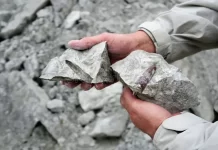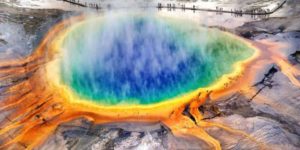
Places To Visit in United States of America
In this Article you will find some of the best natural Places To Visit in United States of America
1. Devils Tower, Wyoming
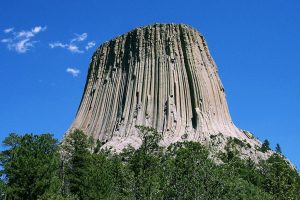
Devils Tower (also recognized as Bear Lodge Butte) is a butt, potentially laccolithic, made up of igneous rock in the Black Hills Bear Lodge Ranger District, close Hulett and Sundance in Crook County, northeast of Wyoming, overlooking the Belle Fourche River. It rises above the Belle Fourche River at 1,267 feet (386 m), sitting at 867 feet (265 m) from top to bottom. The peak is 5,112 feet above sea level (1,559 m).
Devils Tower was the first National Monument to be founded by President Theodore Roosevelt on September 24, 1906. The border of the monument encompasses an area of 1,347 acres (545 ha).
Approximately 1% of the 400,000 annual tourists to the monument have visited the Devils Tower in latest years, mostly using traditional climbing methods and it is the best place to visit in united states of america.
The name Devil’s Tower arose during an expedition led by Colonel Richard Irving Dodge in 1875, when his translator allegedly misinterpreted a indigenous word meaning “Bad God’s Tower.” All data advertisements in that region use the word “Devils Tower,” following a norm of geographical naming that omits the apostrophe.
2. The Wave, Arizona
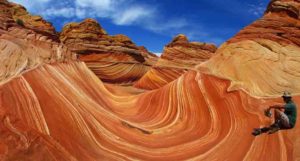
The Wave is a sandstone rock formation situated close its southern boundary with Utah in Arizona, United States. The structure is located on the Coyote Buttes hills in the Colorado Plateau’s Paria Canyon-Vermilion Cliffs Wilderness. The region is managed at the Grand Staircase-Escalante National Monument Visitor Center in Kanab, Utah by the Land Management Bureau (BLM).
Among hikers and photographers, the structure is well known for its colourful, ondulating shapes and the hard walk needed to achieve it and this is one of the best Places To Visit in United States of America. Because of the brittle nature of the training and the big amount of individuals wanting to attend it, the Kanab Visitor Center uses a regular lottery scheme to issue only ten licenses next day in individual. Furthermore, ten internet licenses are accessible four months prior to a scheduled journey for each date. Those who have acquired licenses will receive a map and data about the walk.
The Wave is made up of intersecting U-shaped troughs eroded into Jurassic age Navajo Sandstone. The two main stone forming troughs are 62 feet (19 m) wide by 118 feet (36 m) lengthy and 52 feet (16 m) broad by 7 feet (2 m). Initially, these troughs along joints within the Navajo Sandstone were eroded by rare runoff. The drainage basin, which supplied rainwater to these troughs, shrank after their creation to the stage that the runoff became inadequate to help cut these troughs.
3. Antelope Canyon, Arizona
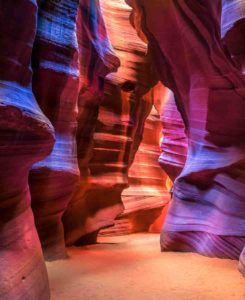
Antelope Canyon is an American Southwest slot canyon. It’s on the west of Page, Arizona, Navajo territory. Antelope Canyon involves two distinct, picturesque canyon slot segments, separately referred to as ‘ Upper Antelope Canyon ‘ or ‘ The Crack ; ‘ and ‘ Lower Antelope Canyon ‘ or ‘ The Corkscrew. ‘
Tsé bighánílíní is the name Navajo for the Upper Antelope Canyon, which implies’ the location where water passes through trees.’ The Lower Antelope Canyon is the Navajo Parks and Recreation Department’s Hazdistazí (called “Hasdestwazi”), or’ spiral stone arches.’ Both are in the Navajo Nation’s LeChee Chapter. The canyons can only be accessed through a guided trip, This is a best place to feel happy and joy so it is one of best of Places To Visit in United States of America.
Navajo Sandstone erosion created the Antelope Canyon, mainly owing to flash flooding and secondary owing to other sub-aerial procedures. Rainwater flows into the expansive basin above the slot canyon segments, particularly during the monsoon season, picking up velocity and sand as it flows through the tight passages. The passages deteriorated over moment, deepening the hallways and brushing difficult corners in such a manner that distinctive “flowing” forms in the rock were formed.
4. Dry Tortugas National Park, Florida
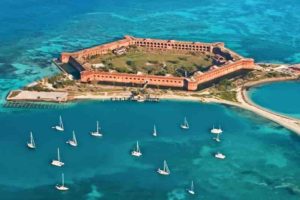
Dry Tortugas National Park is about 68 miles (109 km) south of Key West in the Gulf of Mexico, a national park in the United States. The park retains Fort Jefferson and the seven islands of Dry Tortugas, the Florida Keys ‘ most remote and westernmost. The coral reefs of the archipelago are the least damaged of the reefs of Florida Keys.
The park is known for its abundant marine life, tropical bird breeding grounds, colourful coral reefs, shipwreck myths and sunken treasures. Fort Jefferson, a huge but incomplete coastal fortification, is the centerpiece of the park. Fort Jefferson is the Western Hemisphere’s biggest brick masonry structure, consisting of over 16 million bricks. Only Fort Monroe, Virginia, and Fort Adams, Rhode Island, exceed it in size among U.S. bases. Dry Tortugas is distinctive in its mixture with important historical artifacts of a mainly undisturbed tropical ecosystem.
The park is only accessible by seaplane or boat and has an average of approximately 63,000 visitors per year between 2008 and 2017. Snorkeling, picnicking, bird watching, hiking, scuba diving, fishing for saltwater and kayaking are some of the activities.
Dry Tortugas National Park is part of the Biosphere Reserve of Everglades & Dry Tortugas, established by UNESCO under its Man and Biosphere Program in 1976.
5. Yellowstone National Park, Wyoming, Montana, and Idaho

Yellowstone National Park is a Wyoming, Montana, and Idaho American domestic park. It was set up by the U.S. Congress and President Ulysses S. Grant entered it into law on March 1, 1872. Yellowstone was the first national park in the U.S. and the first national park in the globe is also commonly kept. The park is renowned for its wildlife and numerous geothermal features, including Old Faithful Geyser, one of its most famous characteristics. It has many kinds of ecosystems, but the most common is the subalpine forest. It is component of the ecoregion of the South Central Rockies forests “Amazing places to visit in united states of america”.
Native Americans have resided for at least 11,000 years in the Yellowstone region. During the early-to-mid-19th century, apart from trips by mountain men, structured exploring did not start until the early 1860s. Originally, park management and control falls within the jurisdiction of the Interior Secretary, the first being Columbus Delano. But the U.S. Subsequently, the Army was commissioned to oversee Yellowstone management for a period of 30 years from 1886 to 1916.
Yellowstone is on the southeastern edge of the Snake River Plain, a large U-shaped curve through the hills stretching from Boise, Idaho about 400 miles (640 km) south.
Yellowstone volcanism is thought to be related to the Snake River plain’s somewhat earlier volcanism. Thus, Yellowstone is the active component of a hotspot that over time has shifted south. The source of this volcanic hotspot is controversial. One hypothesis argues that a mantle plume led the Yellowstone hotspot to migrate south, while another hypothesis explains migrating hotspot volcanism as a consequence of the fragmentation and dynamics of the subdued Farallon Plate in the middle of Earth.
The Yellowstone Caldera is North America’s biggest volcanic scheme. It was called a “supervolcano” because extremely big explosive eruptions created the caldera. It is projected that the magma chamber below Yellowstone is a single linked tank, approximately 37 miles (60 km) long, 18 miles (29 km) broad and 3 to 7 miles (5 to 12 km) depth.
6. Haiku Stairs of Oahu, Hawaii
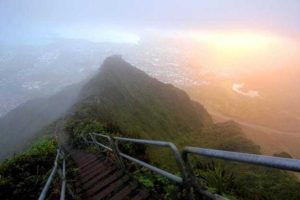
The Haalikū Stairs, also referred as the Heaven Stairway or Haalikū Ladder, is a challenging walking path on Hawaii’s island of Oalmahu. The total of 3,922 steps cover the mountain range of Oahu’s Ko’olau. “Haiku” refers not to the poetry genre of Japan. The region is named after the Kahili flower “Ha regikū.”
Contractors for the United States in 1942 Navy started the development of the Haferikū Radio Station, a top secret unit to be used to convey radio signals to Navy vessels then working across the Pacific. In order to obtain the necessary height for the antennae, they were stretched by the Navy across the natural amphitheater, Haifikū Valley. In addition to the metal steps, some remaining sections of the wooden ladder can still be seen.
7. Hamilton Pool, Texas
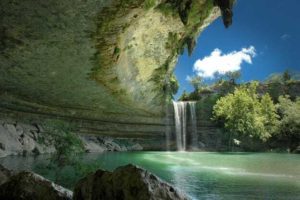
Hamilton Pool Preserve is a natural pool that was formed as a result of huge erosion thousands of years earlier when an underground river dome crashed. Around 23 miles (37 km) north of Austin, Texas off Highway 71, the pool is situated. Hamilton Pool has been a famous summer swimming place for tourists and inhabitants of Austin since the 1960s. Hamilton Pool Preserve is a preserved natural habitat of 232 acres (0.94 km2) with a jade green pool in which a 50-foot (15 m) waterfall flows with water temperatures exceeding 50 degrees Fahrenheit.
The pond is enclosed by big calcareous rocks that lie at the bottom of the water; big stalactites develop from the top of the roof. Moss, maidenhair fern and cliff swallows are close to the grotto’s roof and adjacent hills. The preserve’s Ashe juniper (cedar) uplands are home to the endangered warbler golden-cheeked.
There is no chemical treatment of the natural pool and creek, so water quality is constantly tracked and swimming is sometimes limited. Hamilton Pool is a protected area, part of the Balcones Canyonlands Preserve.
8. Horseshoe Bend, Arizona
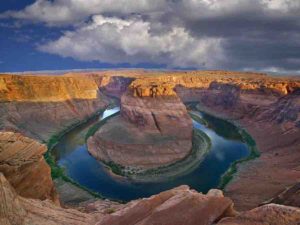
Horseshoe Bend is a Colorado River incised horseshoe meander close the city of Page, Arizona, USA, This is from the best places to visit in united states of america.
Horseshoe Bend is situated in the Glen Canyon National Recreation Area, about 4 miles (6.4 km) southeast of Page, 5 miles (8.0 km) upstream from the Glen Canyon Dam and Lake Powell.
It is available from a parking area near the U.S. by walking a 1.5-mile (2.4 km) round journey. Route 89 on the southwest side of Page.
From the steep cliff above, you can see Horseshoe Bend.
The view is 4,200 feet (1,300 m) above sea level, and the Colorado River is 3,200 feet (980 m) above sea level, resulting in a fall of 1,000 feet (300 m).
The lookout has recently become a significant place for tourists. By 2018, social media place mentions had prompted a significant rise in the amount of tourists.
9. Bryce Canyon, Utah
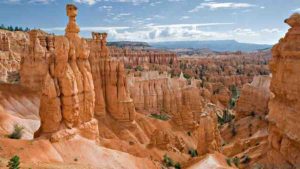
Bryce Canyon National Park is an American domestic park in southeastern Utah. The park’s main characteristic is Bryce Canyon, which is not a canyon despite its title, but a series of gigantic natural amphitheaters along the Paunsaugunt Plateau’s southern edge. Bryce is characteristic because of the geological structures called hoodoos, which are created by frost weathering and river and lake bed erosion of sedimentary rocks. The rocks ‘ red, orange, and white colours provide park tourists with amazing opinions. Bryce Canyon National Park is much lower than neighboring Zion National Park and lies at a much higher elevation. The rim at Bryce varies from 8,000 to 9,000 feet (2,400 to 2,700 m).
The area of Bryce Canyon was settled in the 1850s by Mormon pioneers and was named after Ebenezer Bryce, who in 1874 lived in the area. Originally appointed as a national monument by President Warren G. Harding in 1923, the region around Bryce Canyon was redesigned by Congress in 1928 as a national park.
The park includes 35,835 acres (55,992 sq mi; 14,502 ha; 145,02 km2) and gets significantly fewer tourists than Zion National Park (approximately 4.3 million in 2016) or Grand Canyon National Park (approximately 6 million in 2016), owing mainly to the more distant place of Bryce. Bryce Canyon got 2,365,110 recreational tourists in 2016, a 35 percent boost from the previous year.
10. Lake Tahoe, California/Nevada
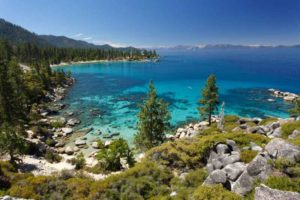
Lake Tahoe in the U.S. Sierra Nevada is a big freshwater lake. Situated at 6,225 ft (1,897 m) south of Carson City, it straddles the state boundary between California and Nevada. Lake Tahoe is North America’s biggest alpine lake and passes only the five Great Lakes as the biggest by quantity in the United States at 122,160,280 acres (150.7 km3). Its elevation is 501 m (1,645 ft), making it the second longest in the United States after Oregon’s Crater Lake (1,949 ft or 594 m).
The lake was created as portion of the Lake Tahoe Basin about two million years ago, shaping the contemporary magnitude during the ice ages. It is renowned on all sides for the clearness of its water and the panorama of neighboring hills. Also known as Lake Tahoe, or merely Tahoe, is the region surrounding the lake. More than 75% of the lake’s catchment is domestic forest property, which includes the U.S. Forest Service’s Lake Tahoe Basin Management Unit so this is one of Places To Visit in United States of America.
Lake Tahoe is one of Nevada and California’s main tourist attractions. It is home to year-round winter sports, indoor summer recreation, and landscapes. Snow and ski resorts are a major component of the economy and reputation of the area. Several lakeside casino casinos are also available on the Nevada hand, with roads offering year-round access to the whole region.
11. Badlands National Park, South Dakota
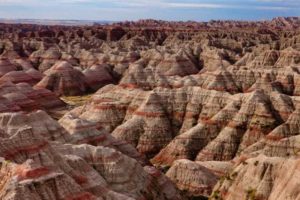
Badlands National Park is a national park in the southwest of South Dakota. In addition to the biggest undisturbed mixed grass prairie in the United States, the park protects 242,756 acres (379.3 sq mi; 982.4 km2) of significantly eroded buttes and pinnacles. The park is managed by the National Park Service, with the South Unit co-managed by the tribe of Oglala Lakota, from the best places to visit in united states of america.
The Badlands Wilderness preserves the park’s 64,144 acres (100.2 sq mi; 259.6 km2) as a specified wildlife area, and is one location where the black-footed ferret, one of the world’s most endangered mammals, has been brought into the wild. The South Unit, or Stronghold District, includes sites of 1890s Ghost Dances, a former U.S. Air Force bomb and gunnery range, and Red Shirt Table, the highest point of the park at 1,020 m (3,340 feet).
It was not established until January 25, 1939, authorized as the Badlands National Monument on March 4, 1929. On November 10, 1978, Badlands was redesigned as a national park. The Ben Reifel Visitor Center was built for the memorial in 1957–58 under the Mission 66 scheme. The monument also administers the National Historic Site of the neighboring Minuteman Missile. Partially filmed in Badlands National Park were films such as Dances with Wolves (1990) and Thunderheart (1992).
12. Palouse Falls, Washington
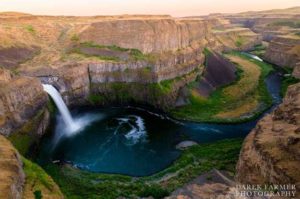
The Palouse Falls are located on the Palouse River, approximately 4 miles (6 km) downstream of the Snake River confluence in southeast Washington, USA. The height of the drops is 198 ft (60 m). The hills comprise of an upper drop with a drop of about 20 ft (6.1 m), 1000 ft (305 m) north-northwest of the primary drop, and a smaller drop with a drop of 198 ft (60 m).
The canyon at the cliffs is 115 m (377 ft) profound, showing the Columbia River Basalt Group’s big cross-section. These hills and the upstream canyon are an significant characteristic of the channeled scablands formed during the Pleistocene era by the huge rains of Missoula that periodically spread across eastern Washington and across the plateau of the Columbia River is amazing Waterfall you must visit in Places To Visit in United States of America.
The ancient river Palouse flowed to the Columbia River through the presently dry Washtucna Coulee. The Palouse Falls and adjacent canyons were formed when the Missoula floods overturned the ancient Palouse River’s southern valley wall, diverting it by erosion of a fresh channel to the present route to the Snake River.
The region is distinguished by interconnected and suspended flood-created coulees, cataracts, diving basins, kolk-created potholes, rock benches, buttes, and typical scabulary pinnacles. Palouse Falls State Park is situated at the falls, preserving this unique portion of the picturesque region.
13. Nā Pali Coast State Park, Hawaii
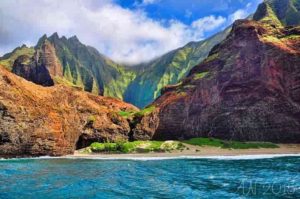
The Nā Pali Coast State Park is a Hawaiian national park of 6,175 acres (2,499 ha) situated in the middle of the hilly 16 miles (26 km) along Kauai’s southwest coast, the longest inhabited Hawaiian island. The coast of Nā Pali itself stretches southeast from Kee Beach to Polihale State Park. The na bari (elevated hills) rise above the Pacific Ocean as elevated as 4,000 feet (1,200 m) along the coast. To safeguard the Kalalau Valley, the State Park was created.
The Hono O Nā Pali State Natural Reserve is located to the south of the national park. It was set up in 1983 and expanded in 2009 to more than 3,578 acres (14.5 km2). Hiking paths and highways for visitors in Waimea Canyon have access to the steep slopes from Koke’e Road (route 550).
14. Glacier National Park, Montana
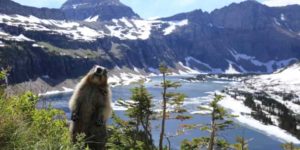
Glacier National Park is an American national park situated on the Canada-U.S. border in southeastern Montana, close to Alberta and British Columbia regions of Canada. The park covers more than 1 million acres (4,000 km2) and contains sections of two mountain ranges (the Rocky Mountains sub-ranges), more than 130 named lakes, more than 1,000 distinct plant species, and hundreds of animal species. This vast untouched ecosystem is at the center of what has been called the “Crown of the Continent Ecosystem,” an area of 16,000 square miles (41,000 km2) of protected territory.
Native Americans first populated the region that became the Glacier National Park. When European explorers arrived, it was dominated in the east by the Blackfeet and in the west by the Flathead. Under stress, the Blackfeet surrendered to the federal government in 1895 the hilly sections of their treaty lands; it subsequently became component of the park. Soon after the park was set up on May 11, 1910, the Great Northern Railway built a range of accommodations and chalets.
15. Thor’s Well, Oregon
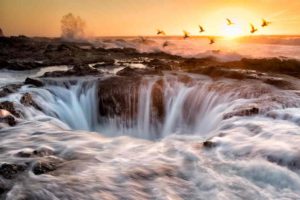
There is a natural cave on the shore of Oregon that seems to drain the ocean.
At high tide, or during floods, the place is most impressive when water washes violently over the rocks and funnels into the cave. Unattended tourists to the site run the danger of being thrown straight into the maelstrom during these sudden torrents. Photographers and nature enthusiasts proceed to flock to the magnificent fountain, regardless of the hazards, to see the hostile waters that live up to the stormy character of their godly namesake. The best time to check Thor’s Well is to watch it without water one hour before the high tide and then watch the structure fill up.
16. Sequoia National Park, California
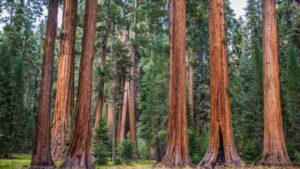
Sequoia National Park in the central Sierra Nevada south of Visalia, California, is an American national park. The reserve was created on September 25, 1890 to safeguard 404,064 acres of wooded hilly land (631 sq mi; 163,519 ha; 1,635 km2). The park includes the highest point in the contiguous United States, Mount Whitney, at 14,505 feet (4,421 m) above sea level, covering a vertical relief of nearly 13,000 feet (4,000 m).
The park is north of and adjacent to Kings Canyon National Park ; the two areas are administered as Sequoia and Kings Canyon National Parks by the National Park Service together. The Sequoia-Kings Canyon Biosphere Reserve was named by UNESCO in 1976.
The park is noteworthy for its giant sequoia forests, including the General Sherman tree, Earth’s biggest tree. In the Giant Forest, which includes five of the world’s ten largest trees, the General Sherman tree develops. The Giant Forest is linked to General Grant Grove, home of the General Grant tree among other giant sequoias, by the Generals Highway to Kings Canyon National Park.
17. Niagara Falls, New York
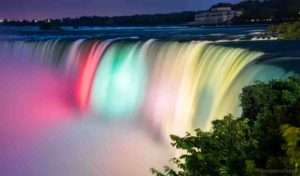
Niagara Falls is a town in the county of Niagara, New York, USA. The town had a complete population of 50,193 as of the 2010 census, down from the 55,593 reported in the census of 2000. It is close to the Niagara River, across from Niagara Falls City, Ontario, and named after the well-known Niagara Falls they share. The town is located within the Metropolitan Statistical Area of Buffalo–Niagara Falls and the West New York area, This is from amazing places to visit in united states of america.
While the town was formerly occupied by Native Americans, Europeans who moved in the mid-17th century to the Niagara Falls started opening up companies and developing infrastructure. Scientists and entrepreneurs later started to harness the capacity of the Niagara River for electricity in the 18th and 19th decades, and the town started to attract producers and other companies attracted by the offer of cheap hydroelectric power. However, following an effort at urban renewal under then-Mayor Lackey, the town and region experienced an financial decrease after the 1960s.
18. Great Smoky Mountains, North Carolina/Tennessee
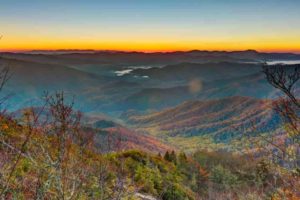
The Great Smoky Mountains are a hill range that rises in the southern United States along the Tennessee–North Carolina boundary. They are an Appalachian Mountains sub-range and are component of the Physiographic Province of the Blue Ridge. Sometimes the range is called the Smoky Mountains and the name is usually abbreviated to the Smokies. The Great Smokies are best regarded as the headquarters of the National Park of the Great Smoky Mountains, protecting most of the area. Established in 1934, the park is the most visited national park in the United States with over 11 million visits per year.
The Great Smokies are component of a Biosphere Reserve International. The range is home to an approximately 76,000 ha (187,000 acres) of old growth forest, the biggest such cluster to be found west of the Mississippi River. One of the most varied ecosystems in North America is the cove hardwood forests in the reduced altitudes of the range, and the Southern Appalachian spruce-fir forest that covers the upper parts of the range is the biggest of its kind. The Great Smokies are also home to the Eastern United States ‘ densest black bear population and the most varied salamander community outside the tropics.
19. Northern Lights, Alaska
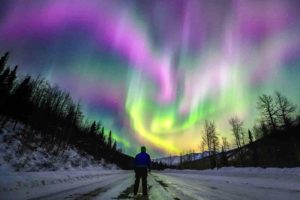
While many tourists believe they must go to Europe to see the Northern Lights, you can truly see this phenomenon without abandoning the United States. There are many Americans heading for the opportunity to see the aurora borealis in northern Alaska. It may be cold in winter (temperatures may drop to-30 ° F), but coastal Alaskan Arctic— where skies tend to be clearer— is one of the world’s greatest locations to see this renowned light display.
20. Carlsbad Caverns, New Mexico
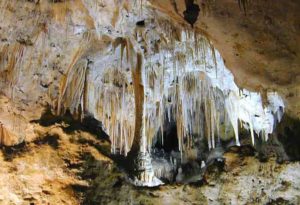
Carlsbad Caverns National Park is an American National Park in southern New Mexico’s Guadalupe Mountains. The park’s main attraction is the Carlsbad Cavern show cave. Visitors to the cave can walk or bring an elevator from the visitor center on their own through the natural door.
On US Highway 62/180, about 18 miles (29 km) southeast of Carlsbad, New Mexico, the park gate is situated. The National Park of Carlsbad Caverns is involved in the Junior Ranger Program. The reserve has two listings on the Historic Places National Register: the Historic District of Caverns and the Historic District of Rattlesnake Springs. Approximately two-thirds of the park has been laid aside as a wilderness area to help guarantee that future habitat modifications are not created.
Carlsbad Cavern contains a big room of calcareous, merely called the Big Room, which is nearly 4,000 feet (1,220 m) long, 625 feet (191 m) broad, and at its lowest level, 255 feet (78 m). The Big Room is North America’s third biggest chamber and the world’s twenty-eighth biggest.







